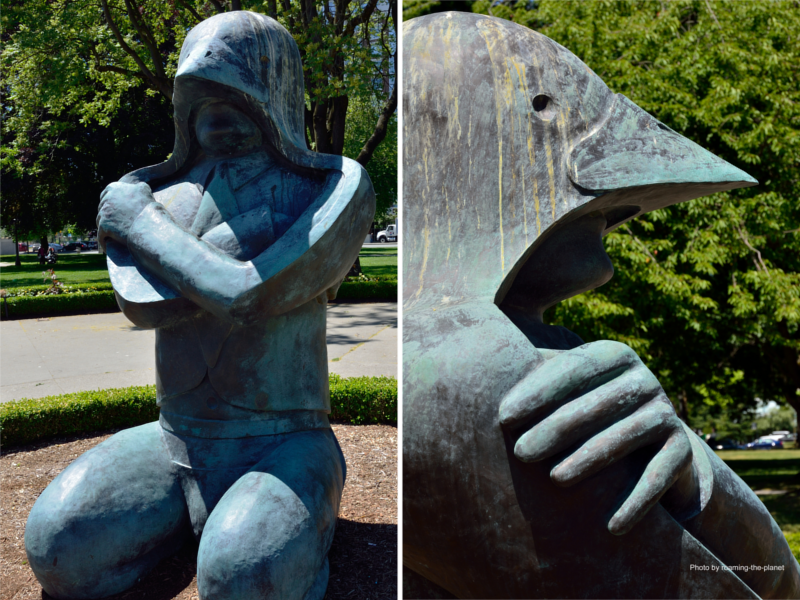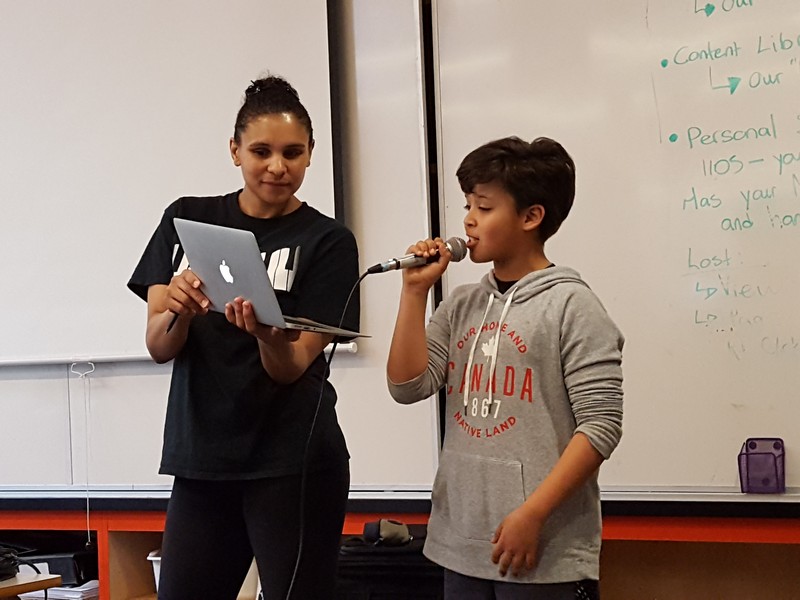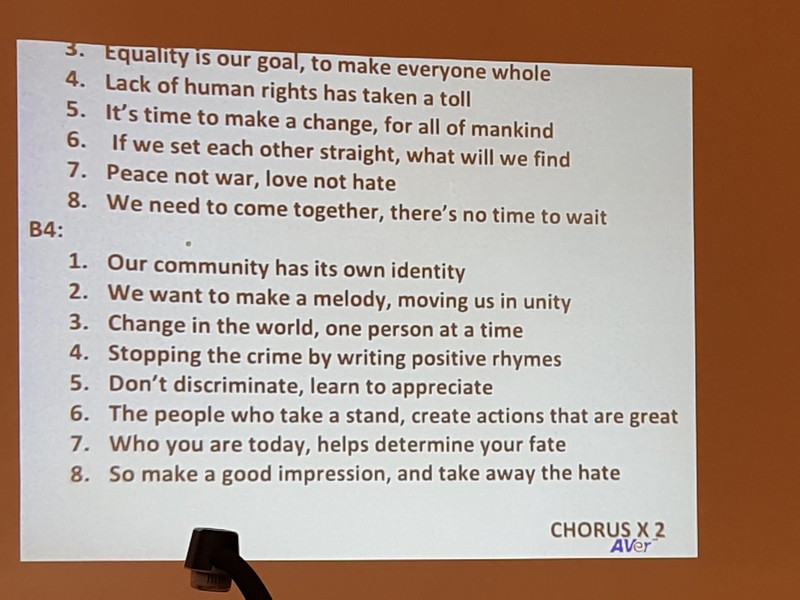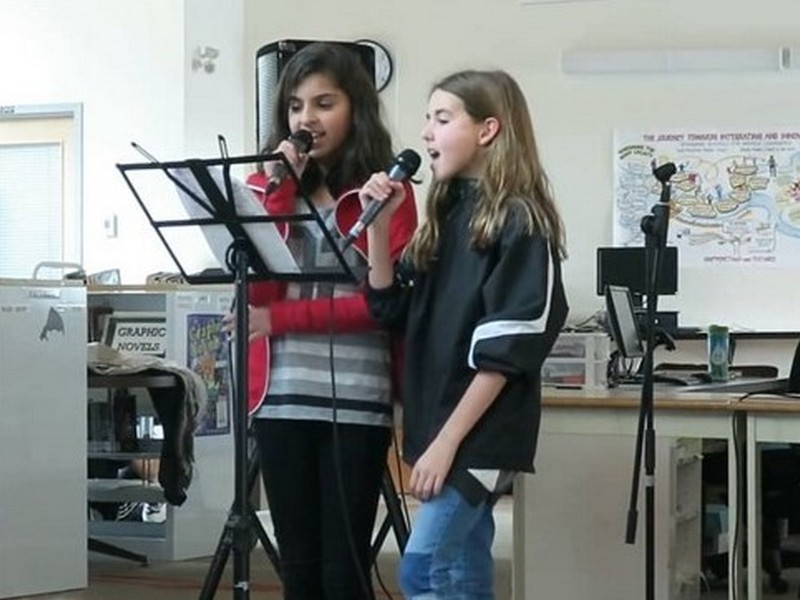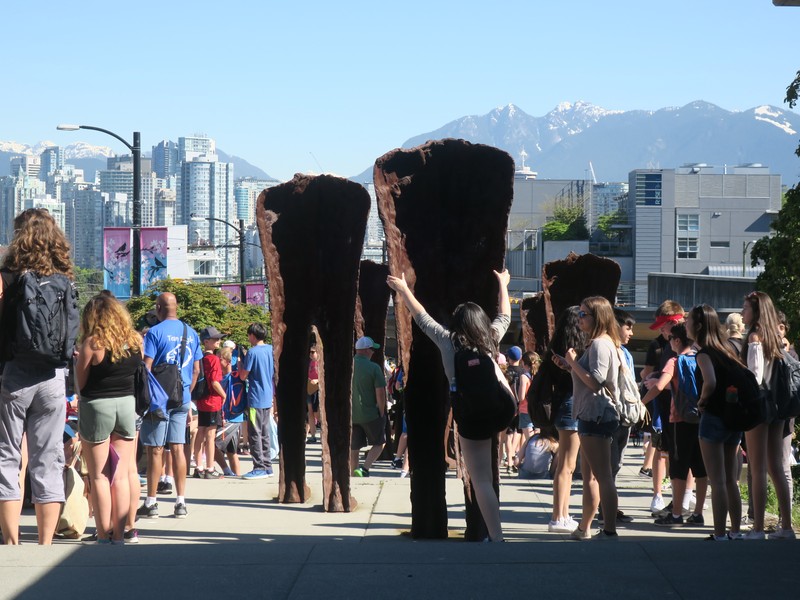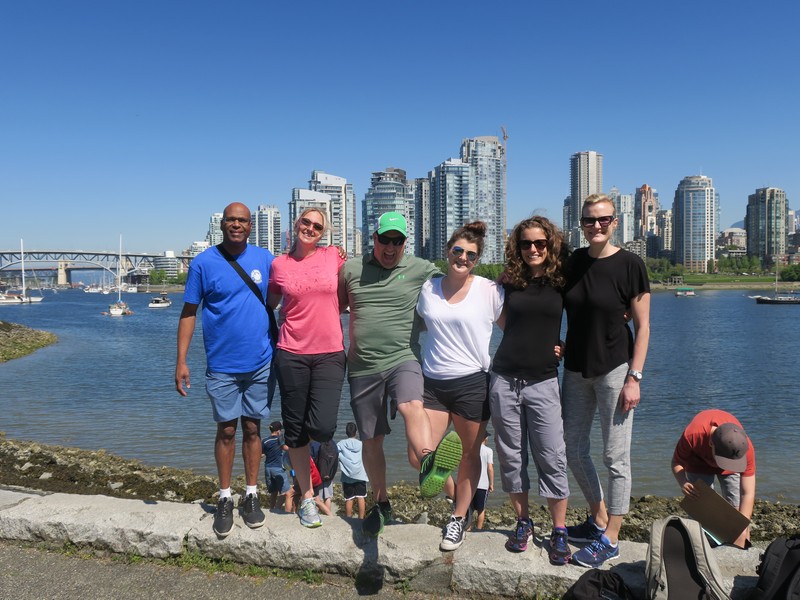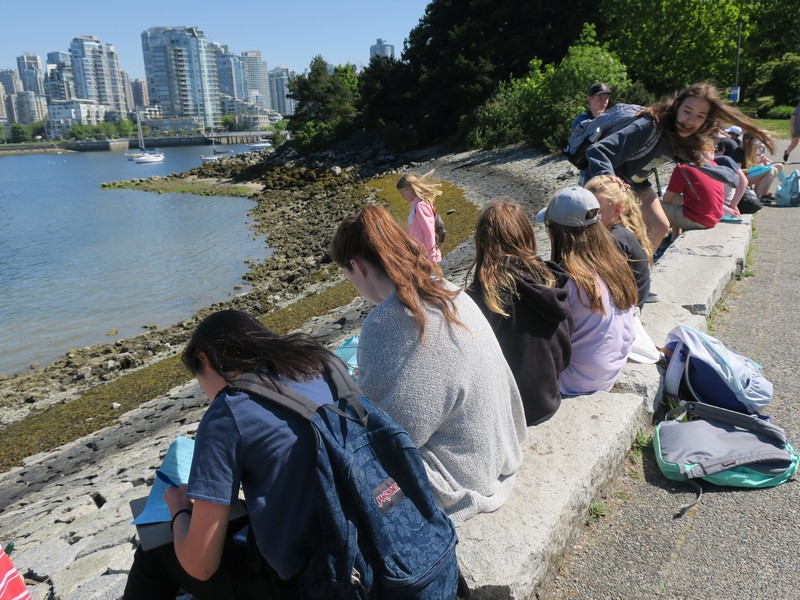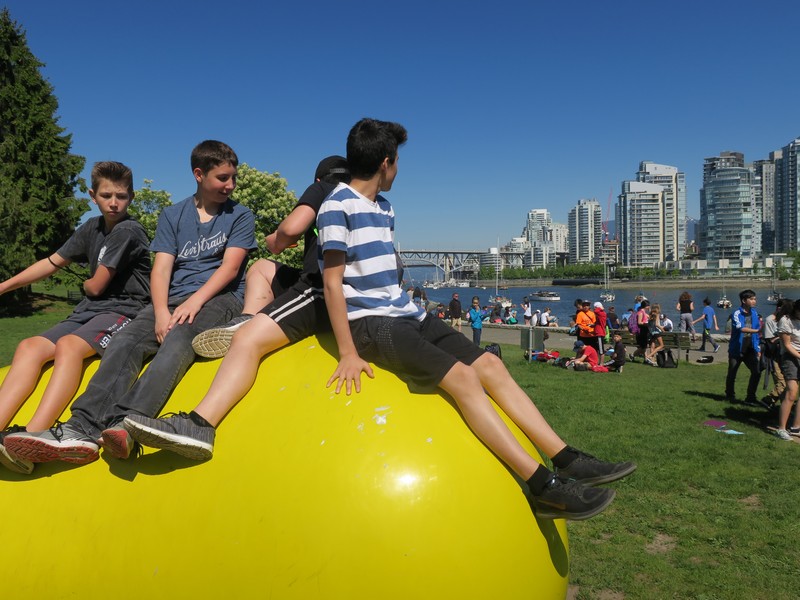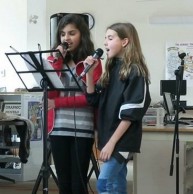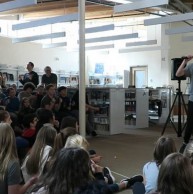Eagle Mountain: How do stories help our identities evolve?
Arts Education, Geography, Information Technology, Language Arts, Social Studies
School: Eagle Mountain
Teacher: Andrea Coupe, Danielle Murdoch, Jenn Moody, Renn Manners, Avie Basson
Artist Collaborators: Kia Kadiri
Class: Grade 6, 6/7 and 7/8 Classes
Overview
Students explore the theme of identity through spoken word. The students investigate how do stories shape identity and how do stories help our identities evolve. This inquiry project inspires youth and encourage them to use creative writing as a means to form global connections. The students discover how youth around the world perceive identity, what nationality means to them and how they can relate to one another. Through an international poetry exchange using a shared folder; the students exchanged their messages with youth in 8 different countries around the world. This exchange create an opportunity for students to create lasting friendships and share stories with other youth from different background.
BIG IDEAS
• Texts are socially, culturally, and historically constructed.
• Language and text can be a source of creativity and joy.
• Questioning what we hear, read, and view contributes to our ability to be educated and engaged citizens
• Exploring stories and other texts helps us understand ourselves and make connections to others and to the world.
Guiding Questions
• How do stories shape identity?
• How do stories help our identities evolve?
Cross-Curricular Access
Spoken word naturally reflects the language arts curriculum however the content of the writing will vary depending on the area of study. Students may choose to create something based off their learning in the traditional subject areas of science, math or social studies. While the product is language arts, the process will encompass curricular pieces from many areas. Social Studies – students will look at representations of the world as told through story, religion, myths, spiritual beliefs and languages.
Project Core Concept
Our school theme is Identity. We are exploring this theme through the use of story. Students have spent the Fall exploring residential schools and the stripping of identity as well as the resilience of identity.
• Using the play Hamilton as a tool for finding figurative language, storytelling of history through spoken word and looking into the key areas Lin Manuel talks about in the documentary from PBS America’s Hamilton (ie the change in pace of speech for certain characters, the story of some of the songs, the role spoken word plays in making history modern)
• Get to know various spoken word artists, story tellers and artists such as Shane Koyzan, Stuart McLean, Lin-Manuel Miranda, Brian Mooney, Ramsford Brempong, and Yuxweluptun
• Students practice oral story telling skills and connect to the First Nations use of it as an integral part of their identity and as a way to record their history.
• Reference Sites:
• http://www.vancouverpoetryhouse.com/
• http://highered.mheducation.com/sites/0072405228/student_view0/poetic_glossary.html
• https://bemoons.wordpress.com/
• Students also explored various art forms (painting, sculpture etc) and ask: what is art? Which leads to the understanding of language as art as well.
• Lessons on public art (from Biennale) was included as well as comparing viewing art such as a sculptures with listening to spoken word – how do we ‘view’ them and are they the same?
• Students explored the major religions (including one indigenous to North America) through their creation stories. This also build on the idea of storytelling as an art form
The Vancouver Biennale Art Inquiry Experience
This project is inspired by the Vancouver Biennale artwork Bird Wrap by Canadian artist Evan Eyre. The piece tells a story of identity by combining man and beast. Students explore the idea of how stories explain our world. Explore how we are also tied to the natural world and that our identities are complex, can be multi-layered and share characteristics with our natural world.
In addition, the other inspirational art piece for this project is Giants by Brazilian artist OSGEMEOS at Granville Island where the students explore this public art piece of multiple colourful figures with uniform shapes and yet with different gestures and outfits and its impact on those viewing it as well as how it affects and impacts the space it’s in (identity of place).
Other Inspirations/Resources
Spoken word artists, story tellers and artists such as Shane Koyzan, Stuart McLean, Lin-Manuel Miranda, Brian Mooney, Ramsford Brempong, and Yuxweluptun
http://www.vancouverpoetryhouse.com/
http://highered.mheducation.com/sites/0072405228/student_view0/poetic_glossary.html
https://bemoons.wordpress.com/
Learning Process
This inquiry project inspires youth and encourage them to use creative writing as a means to form global connections. The students discover how youth around the world perceive identity, what nationality means to them and how they can relate to one another. Through an international poetry exchange using a shared folder; the students exchanged their messages with youth in 8 different countries around the world. This exchange create an opportunity for students to create lasting friendships and share stories with other youth from different background.
Using spoken word poetry, rap and music, students create online profiles to be shared with youth in over 8 countries.
Students use poetry and songs to explore the themes of identity and discover how youth around the world can evolve through storytelling.
Students incorporate poetic devices and performance techniques, as they develop their individual and group writing skills.
The students’ final poetry pieces are recorded and added to their online profiles, as well as performed in a presentation for guests and students to attend.
Art-Infused Learning Process
The goals of the artistic creation:
• Students to create a spoken word piece reflecting their understanding of figures of speech, the power of poetry and speaking skills.
• Live presentations and each individual can ‘perform’ their piece in differ way – groups, pairs, independently.
• The topic of their spoken word will be open to them and approached using inquiry (students create a question to explore through their spoken word).
The students complete a series of poetry assignments that explored their nationalities, goals, dreams, and personal reflections. Each student worked with their teachers to create an on-line personal profile consisting of these assignments, pictures and final spoken-word works of poetry. All students read their final assignments in front of their peers, and some youth elect to record and/or perform their solo pieces. The objective was to do an exchange of our profiles with youth around the world.
In addition to the solo assignments, the students also worked together in 3 large groups to create group songs. This involved them working together in teams to collectively write, and each youth was involved in the recording process and the final musical performance/presentation. The final outcome was a fabulous performance filled with spoken word, recorded music & poems, live poetry readings, photo slideshows, dance routines, and an entertaining performance by several of the teachers!
The last piece of this project will be an on-going process. Eagle Mountain was able to connect with over 8 teachers around the world who are interested in doing an exchange of the poetry exercises and assignments by the students. Through this global connection, this creates opportunities for dialogue concerning the different types of global issues and experiences kids in other countries are experiencing.
Reflection
Artist -Kia Kadiri
This year I had the pleasure of working with teachers Andrea Coupe, Danielle Murdoch, Jenn Moody (to name a few), and their grade 6/7/8 students from Eagle Mountain Middle School. It was an honor to be chosen as the first choice by these teachers, to inspire and assist the youth with the creation of their own bodies of work, using a spoken word platform. It was their intention to expose 150 students to a variety of prose, poetry, writing techniques and performance skills; centered on the themes of storytelling and how stories shape our identities.
Although this is my 3rd year working as an artist with the Vancouver Biennale, and the 3rd year that this school has participated in BIG IDEAS projects, when I was first approached for the project I was hesitant of the large group sizes the teachers were suggesting. With 40-50 kids attending each workshop, I was concerned that it would be a challenge for me to make meaningful connections with students. After meeting with the teachers to discuss the project and observe the layout of the school classrooms, I was a lot more comfortable and confident that I would be able to deliver the objectives outlined in the grant proposal they submitted to the Vancouver Biennale.
First let me say that these teachers were amazing to work with. They are by far the most passionate, involved, dedicated, helpful and committed teachers; that I have met in my many years of working as an artist in schools! They work as a team, they are passionate about every aspect of what the Biennale represents and I strongly believe in the approach to teaching that they are developing at this school. They were incredibly supportive, flexible and available to assist me in every way during this wonderful creative exploration!
The guiding questions for the project focused on how stories shape identity, and how stories help identities evolve. To connect this project to this years BIG IDEA theme – Making Global Connections, I decided to have the students complete a series of poetry assignments that explored their nationalities, goals, dreams, and personal reflections. Each student worked with their teachers to create an on-line personal profile (based on a template that I developed) consisting of these assignments, pictures and final spoken-word works of poetry. All of the students were required to read their final assignments in front of their peers, and certain youth were selected to record and or perform their solo pieces. The objective was to do an exchange of our profiles with youth around the world.
In addition to the solo assignments, the students also worked together in 3 large groups to create group songs. This involved them working together in teams to collectively write, and allowed each youth to be involved in the recording process and the final performance/presentation of our music. The students were awesome to work with, and I was very impressed with all the work they accomplished in such a short amount of time. The final outcome was a fabulous performance filled with spoken word, recorded music & poems, live poetry readings, photo slideshows, dance routines, and an entertaining performance by several of the teachers!
The last piece of this project will be an on-going process. I was able to connect with over 8 teachers around the world who are interested in doing an exchange of the poetry exercises and assignments that these youth completed. My goal was to connect the students with youth around the world, and create dialogue concerning the different types of global issues and experiences kids in other countries are experiencing. Unfortunately due to time constraints, schedule conflicts and unavoidable circumstances, I was unable to complete the poetry profile exchanges during my time with the Eagle Mountain students. As this was an additional portion to the teacher’s main objective, I still feel that I met my expectations for the project. I plan on completing some form of international poetry exchange, and re-visiting Eagle Mountain for a final share-back and goodbye celebration.
In conclusion I would like to thank the all the teachers, staff and students at Eagle Mountain Middle School for inviting me to be a part of their artistic exploration. I’d also like to thank the Vancouver Biennale for providing me with another incredible experience and the opportunity to inspire and be inspired by youth in our community.
